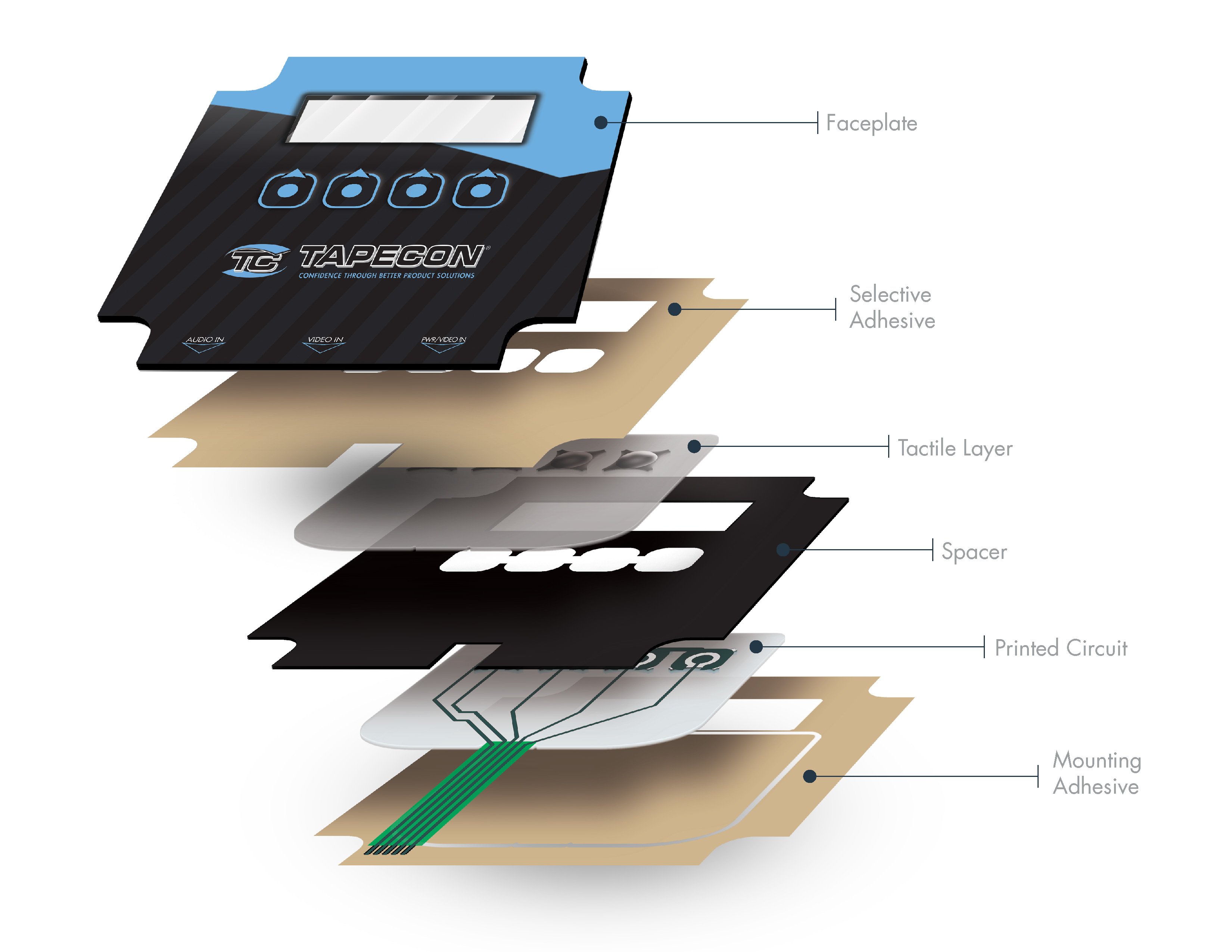Exactly How a Membrane Switch Boosts User Experience and Gadget Performance
Exactly How a Membrane Switch Boosts User Experience and Gadget Performance
Blog Article
Recognizing the Performance of Membrane Changes for Interface Gadget
The functionality of membrane switches represents a substantial advancement in interface design, combining effectiveness with aesthetic versatility. These buttons run via a multi-layered framework that equates customer communications into electric signals, permitting both portable layouts and resilience against environmental factors. As sectors increasingly prioritize user experience, recognizing the nuances of membrane layer button modern technology becomes important. What implications do these developments hold for future applications, and how might they redefine customer interactions throughout numerous tools?
What Are Membrane Layer Buttons?
Membrane layer buttons are cutting-edge interface devices that promote user communication with digital tools. These versatile components consist of several layers, including a graphic overlay, spacer, and a published circuit layer. The layout permits for a smooth integration into numerous electronic gadgets, boosting both the aesthetic and practical facets of customer interfaces.
Membrane layer buttons are commonly employed in a vast variety of applications, from family appliances to commercial equipment and clinical tools. Their building and construction usually includes a thin profile, making them an excellent selection for small layouts. The tactile responses provided by these switches can be crafted to satisfy specific customer preferences, ensuring efficient communication between the user and the tool.
Durability is an additional significant benefit of membrane layer buttons, as they are resistant to dirt, moisture, and chemicals, which enhances their life-span in demanding atmospheres. In addition, these buttons can be customized in regards to shape, size, and graphic style, permitting branding and user-specific attributes. Overall, membrane layer switches stand for a functional service for enhancing customer experience in electronic tools, combining capability with visual appeal in a reliable fashion.
Just How Membrane Changes Job
Operating on an uncomplicated concept, membrane layer switches over make use of a layered construction to sign up individual input properly. Each button is composed of multiple layers, including a printed circuit layer, a spacer layer, and a leading graphic layer, which are developed to interact seamlessly. When a user presses the leading layer, it presses the spacer layer, bringing the conductive elements of the circuit layer into contact with each other.
This contact creates a closed circuit, signifying the tool to perform a certain feature. The layout enables for numerous arrangements, consisting of tactile feedback, which can boost the customer experience by providing a physical experience upon activation. The products used in membrane layer switches usually consist of versatile substrates, such as polyester or polycarbonate, which ensure durability and strength versus damage.

Key Advantages of Membrane Switches

One more significant advantage is their density. Membrane layer buttons are thin and light-weight, which enables producers to conserve area in their tools without sacrificing performance. This feature is particularly advantageous in applications where weight and volume are essential considerations.
In addition, membrane buttons are resistant to dust, dampness, and chemicals, boosting their resilience. This durability expands their lifespan and lowers the demand for constant substitutes, leading to cost savings in time.
Additionally, the responsive responses provided by membrane layer switches can be maximized to improve individual interaction. They can consist of attributes such as increased buttons or distinct clicks, boosting usability and customer experience.
Applications Throughout Industries
Interface devices making use of membrane layer switches are common in a vast selection of sectors, showcasing their flexibility and functionality. Membrane Switch. In the medical sector, membrane layer switches are integral to devices such as diagnostic tools and patient tracking systems, Your Domain Name where their durability and ease of cleansing are important for keeping health standards. In the vehicle industry, these switches are used in dashboard controls and infotainment systems, offering a streamlined and modern user interface for customers.
In addition, the customer electronics market take advantage of membrane buttons in appliances and handheld gadgets, where portable layout and user-friendly user interfaces enhance customer experience. Industrial applications also leverage membrane layer changes for control panels in equipment and automation systems, highlighting their effectiveness and resistance to severe atmospheres.
In the aerospace and protection sectors, membrane switches are used in cockpit controls and equipment, where integrity and efficiency under severe problems are extremely important. Additionally, the video gaming industry increasingly incorporates membrane layer buttons in controllers and arcade devices, adding to an interesting individual experience. On the whole, the adaptability of membrane layer switches allows their extensive usage throughout many sectors, emphasizing their value in contemporary interface design.
Future Trends in Membrane Switch Over Technology

In addition, the usage of advanced products, such as polycarbonate and polyester films, is expected to rise, supplying improved sturdiness and resistance to environmental stressors. These materials add to the total long life of membrane layer buttons, making them ideal for harsher industrial applications.
In addition, the incorporation of smart modern technology, including IoT connectivity, will allow membrane buttons to connect with various other tools and systems, assisting in an extra interactive customer experience. useful source This pattern aligns with the growing demand for wise devices throughout various sectors, from medical care to consumer electronics.
Finally, customization alternatives are anticipated to broaden, allowing makers to create bespoke options tailored to particular individual needs and choices. These growths will place membrane layer switches as crucial components in the advancement of interface technology.
Final Thought
In conclusion, membrane layer switches over represent a pivotal improvement in individual interface technology, using a trustworthy and functional option for diverse electronic applications. As improvements in product science and touch noticing technologies continue, the functionality and applicability of membrane switches are anticipated to broaden, reinforcing their relevance in modern-day digital tools.
Report this page